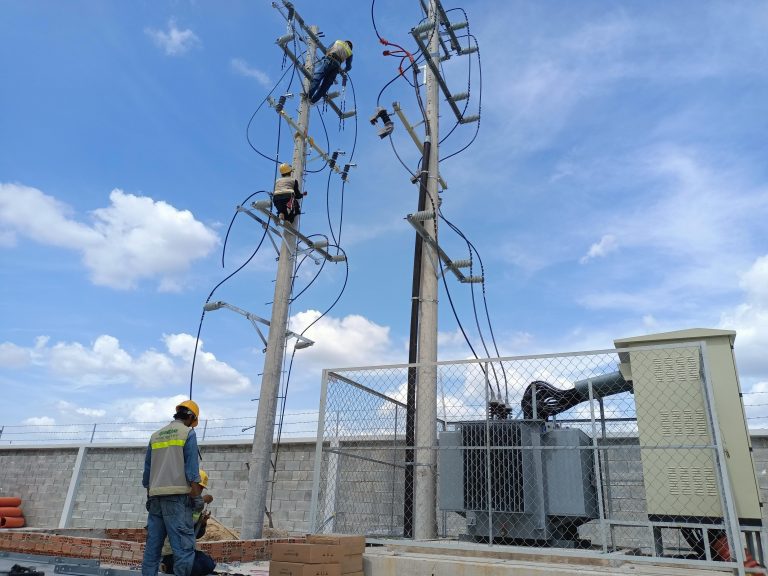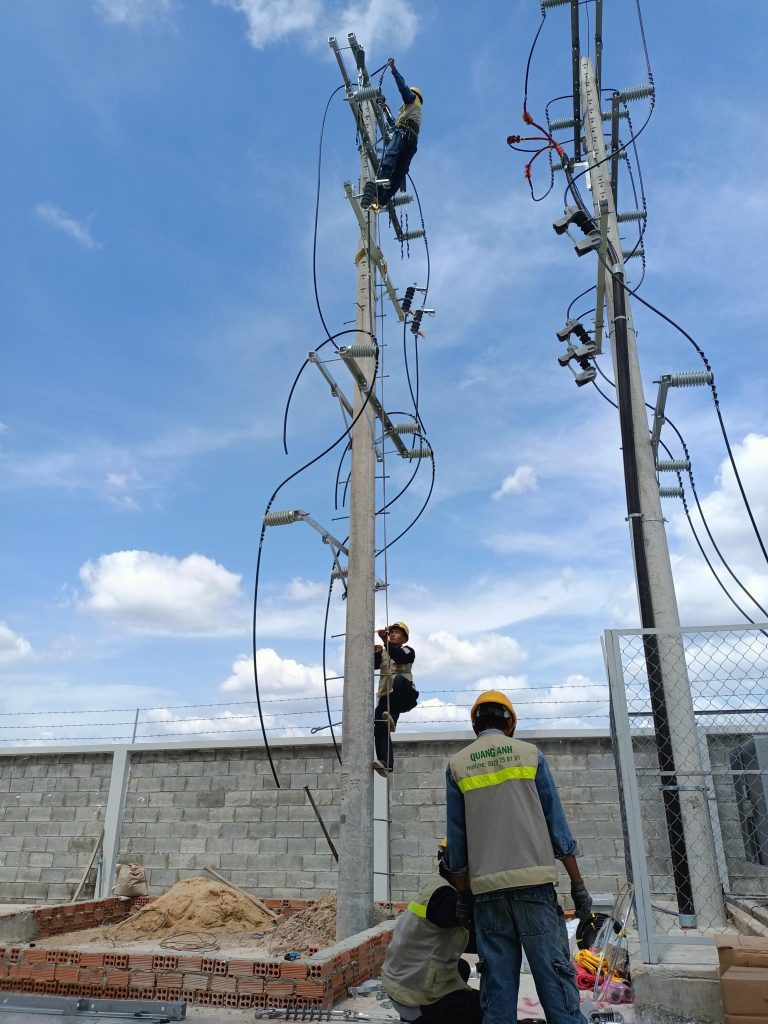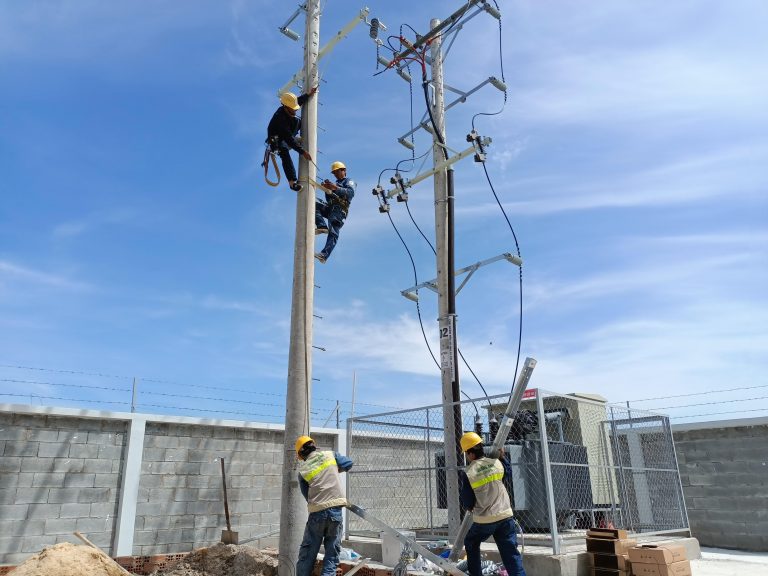Article Contents:
Electrical design for factories is an important aspect of building and operating production facilities to ensure safety, efficiency, and meet the electricity usage needs throughout the operational process.
Factory Electrical Design Process
The factory electrical design process starts with a site survey where engineers collect information about the electrical installation area, factory scale, and machinery quantity. Next is designing the high voltage and low voltage electrical networks, determining the placement of electrical poles, wiring procedures, and ensuring safe distances between electrical networks. Another important part is designing the lighting system, ensuring enough light, considering glare and light color temperature. Finally, designing power factor compensation helps minimize losses and stabilize voltage, ensuring efficient system operation.
Factory electrical design plays a crucial role in building a safe and efficient electrical system. Below are details of each step in the process:
Surveying
- Collect information about the factory’s area, equipment, and power needs.
- Analyze needs including calculating power demand and equipment installation locations.
High Voltage Network Design
- Determine the position of the high voltage poles, ensuring the suitability of the power lines entering the factory.
- Design the power lines ensuring safe distances and strict compliance with current safety regulations.
Low Voltage Network Design
- Electric pole placement is determined to optimize space and ensure electrical safety.
- Arrange the network for maximum safety and efficiency.
Lighting System Design
- Follow technical standards for brightness, glare, and color temperature appropriate for different areas.
- Arrange the number and position of lights so that the light is evenly distributed.
Power Factor Compensation System Design
- Calculate power to design capacitor systems that optimize the power factor and reduce energy loss.
Create CAD Drawings
- Use CAD software to create 2D, 3D drawings, clearly showing the layouts and sections in the design.
Design Approval
- Compare and evaluate the suitability of the design with real requirements and technical specifications before implementation.
Important considerations in factory electrical design include ensuring the system operates safely, efficiently, and complies with technical and environmental protection regulations. Calculating electrical load balance is also essential to ensure smooth and stable system operation.

Factory Electrical Construction Items
Construction of the factory electrical system consists of various items. First, constructing the main power cable system, determining the main cable route and ensuring safety in use. Next is the construction of cable trays to protect and secure electric cables in the factory. Installing industrial electrical cabinets for device connections and protection is an essential step. Finally, constructing the light electrical system including lighting, security cameras, fire alarms, and residential electricity, supporting the comprehensive operations of the factory.
Construction Items for Factory Electrical System
Factory electrical design is an essential part of building a factory to ensure the safety and efficiency of the system. The steps for electrical construction include:
1. Main Power Cable System Construction
The main power cable system plays a key role in the entire factory electrical design. This process usually starts from the transformer station and passes through the MCCB into the main distribution electrical cabinet. Cables can be run openly or buried underground, depending on specific project requirements and installation terrain.
2. Cable Tray Construction
Cable trays not only protect electric cables but also provide an organized solution for cable arrangement. This not only facilitates management but also ensures convenient maintenance procedures. Safety and aesthetics need to be harmoniously integrated into the design and installation of cable trays, in line with the standards of factory electrical design.
3. Industrial Electrical Cabinet Installation
Factory electrical cabinets are the control centers for all areas within the factory. A separate electrical cabinet should be arranged for each production area to facilitate control and maintenance. Additionally, backup should be considered by integrating generators and automatic transfer switch cabinets (ATS) to maintain continuous operations.
4. Light Electrical System Construction
The light electrical system includes lighting, fire explosion alarm, security camera system, and residential electricity. Each factor should be designed to fit the specific requirements of the factory, providing maximum support for production operations and enhancing safety.
Notes in the Design and Construction of Factory Electrical System
- Medium voltage power line and transformer station design: Attention should be paid to capacity and ensuring technical standards.
- Power cable distribution system design: Reasonable cable distribution for optimal operation efficiency.
- Cable tray position design: Ensure safety and aesthetic quality.
- Regular inspection and maintenance: Conduct regularly to maintain stable and safe system operation.
These items need to be closely monitored to ensure the factory electrical system operates efficiently and safely.

Safety and Maintenance Standards for Factory Electricity
Safety standards in factory electrical design ensure the system operates stably and protects people and assets. Compatibility and integration of equipment are carefully considered, ensuring devices meet technical requirements and usage environments. Additionally, maintenance and repair are clearly planned to minimize operational risks and ensure the lifespan of electrical devices.
Electrical Safety Standards
In factory electrical design, electrical safety standards are critical to ensuring the safety of people and infrastructure. Key standards include:
- Implement Safety Regulations: All organizations and individuals using electricity should strictly comply with electrical safety regulations, conducting inspections and maintenance of electrical equipment according to technical standards and electrical safety codes.
- Low Voltage Electrical Equipment: Ensure low voltage electrical equipment is protected against electric shocks and meets grounding and bonding regulations.
- Electrical Stations and Networks: Installed and operated according to prescribed electrical safety technical standards.
- Areas prone to fire and explosion: The electrical system must be designed according to special regulations to prevent fire and explosion risks.
Factory Electrical Maintenance
Maintenance is an indispensable part of factory electrical design to ensure the electrical system operates efficiently and safely. Maintenance principles include:
- Equip Safety Measures: Use labor protection tools to ensure safety in the maintenance area.
- General Inspection: Review factors such as conductors, connection circuits, and device loads.
- Measurement and Testing: Use electrical measuring devices to check insulation properties and detect electrical leaks.
- Periodic Inspection: Conduct system checks regularly to maintain stability and operational safety.
- Report Creation: Complete a report after each inspection to monitor device condition.
Additional Notes
- Safe Distances: Absolutely maintain safe distances from high voltage lines and stations.
- Quality Electrical Devices: Choose equipment from reputable suppliers like ABB, Schneider, Mitsubishi to ensure quality.
- Device Quality Check: Devices need thorough inspection before use, ensuring they have safety seals.
- Grounding: Grounding systems should ensure effective operation to minimize electrical leakage risks.
Reliability-Centered Maintenance
Reliability-centered maintenance (RCM) is a modern method aimed at enhancing the reliability of electrical systems, commonly applied in large factories. The goal is to improve performance, reduce failures, and extend device lifespan.

A proper factory electrical design not only ensures safe and efficient operation but also optimizes energy costs, increases competitiveness, and ensures continuous and stable device operation.
Contact QuangAnhcons via Hotline: 09 1975 8191 for consultation on standard and optimized factory electrical design.
QuangAnhcons specializes in providing factory electrical design services that meet standards, fully addressing safety and operational efficiency requirements for production facilities.